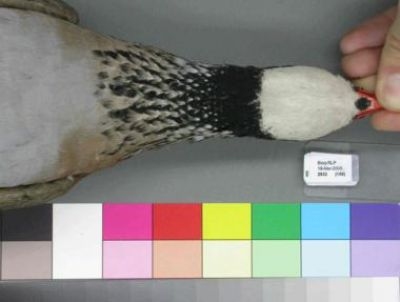
Bibliography
See all- 2013 Trends in Ecology and Evolution 28: 499-500 Fractal geometry for animal biometrics: a response to Kühl and Burghardt
- 2013 Proceedings of the Royal Society B 280: 20122783 Fractal geometry of a complex plumage trait reveals bird’s quality
Fractal geometry deciphers the secret messages of avian plumage
Colour patterns are essential for camouflage and communication, playing key roles in many natural and sexual selection processes. In the last decades, we have made great advances in our understanding the function and expression of these coloured traits. Most of research has focused in colour characteristics (hue, saturation) or in the size of the coloured patch. However, spotted, stripped, and other heterogeneous patterns are ubiquitous in the animal kingdom, but their function remains understudied. This is likely because these designs and colourations are often too complex to be easily and accurately described by simple approaches.
Using fractal geometry to describe complex patterns
How could we describe and quantify these complex colour patterns? Is there any “hidden” information conveyed by them? In that case, how could we decode it? In order to answer these questions, we focused in a scientific field that could seem unrelated to animal ecology: fractal geometry. Fractal geometry is a subdiscipline of Maths that studies fractals, mathematical objects that are too complex to be described by Euclidean geometry. Another characteristic of fractals is that they are autosimilar (i.e. their shape is repeated ad infinitum across scales). Fractals have become very popular in the last decades because of the arresting mixture of chaos and order that they evoke.
Beyond their purely mathematical interest, fractal geometry is also interesting because many natural structures (shape of the coast, habitat structure, plant growing patterns) can be effectively described by their fractal dimension, which is the mathematical tool used to describe fractals. Could it be possible to capture biological information conveyed by a complex colour pattern by quantifying its fractal dimension? We explored this question using the red-legged partridge as a model species. In this species, both sexes exhibit a black conspicuous black bib characterized by a complex pattern of black arrow-like patches against a whitish-grey plumage backdrop. The appeareance of this trait is really difficult (if not impossible) to describe by standard methods.
In a first correlational approach, we found that the fractal dimension of this trait was informative of body condition and immune capacity of individuals. Also, we experimentally manipulated body condition of individuals during moult, finding that birds in low condition during moulted into bibs of lower fractal dimension than those in good nutritional status. Thus, we confirmed a causal relationship between individual condition and ornament fractal dimension.
A fractal perspective of beauty?
This study has been performed in birds, but it opens up a new research window for the study of complex colour traits or to unravel new aspects of simpler ones in any other animal taxa. One of the key features of fractal geometry is its capacity to capture variability in shape and structure across scales. This property makes fractal dimension an interesting tool to capture the variability in animal patterns, that often result from a multi-scaled construction: multiple mechanisms that are synchronized at very different scales (from pigment synthesis and deposition into a single feather, scale or hair, to the coordinated growth and distribution of these units along the entire body), resulting in the final macroscopic appearance of the trait. Factors affecting developmental stability (like the reduction in body condition of our experiment) may alter this machinery, resulting in changes in the fractal dimension of the trait, unveiling low quality individuals.
In some way, we could say that there can be biological information about individuals in their colour patterns, and that it can be decodified with fractal geometry. But, to what extent can animals perceive fractal dimension? Studies in animals addressing this issue are currently lacking. In humans, however, studies have shown that the FD of artworks unconscientiously influences our perceived beauty and preferences, be they purely abstract designs or realistic representations [34-36]. Non-human animals may similarly prefer traits with higher (or lower) fractal dimensions, particularly if these advertise a better individual quality, as we report here. We therefore suggest that considering FD should shed new lights onto the evolution and maintenance of complex animal patterns.
The results of this research have been published in the journal Proceedings of the Royal Society B, within an article signed by : Lorenzo Pérez-Rodríguez, Roger Jovani, Francois Mougeot, entitled : "Fractal geometry of a complex plumage trait reveals bird´s quality ". The pre-print PDF is available on the left-side pannel of this page.
Pictures

 Bib patterning in the red legged partridge (Alectoris rufa) (Photo: L. Perez-Rodriguez)
Bib patterning in the red legged partridge (Alectoris rufa) (Photo: L. Perez-Rodriguez)
 Mandelbrot fractal (Image: Wolfgang Beyer)
Mandelbrot fractal (Image: Wolfgang Beyer)
 Computer generated fractal (Image: Wolfgang Beyer)
Computer generated fractal (Image: Wolfgang Beyer)
 Computer generated fractal (Image: Wolfgang Beyer)
Computer generated fractal (Image: Wolfgang Beyer)
 Red-legged partridge displaying its black bib (Photo: Rafael Palomo)
Red-legged partridge displaying its black bib (Photo: Rafael Palomo)
 Measuring the fractal dimension of bibs (Photo: Lorenzo Pérez-Rodríguez)
Measuring the fractal dimension of bibs (Photo: Lorenzo Pérez-Rodríguez)



